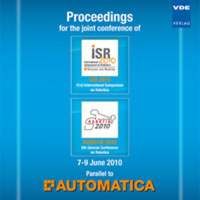Very Compact Climbing Robot rolling on Magnetic Hexagonal Cam-Discs, with High Mobility on Obstacles but Minimal Mechanical Complexity
Conference: ISR/ROBOTIK 2010 - ISR 2010 (41st International Symposium on Robotics) and ROBOTIK 2010 (6th German Conference on Robotics)
06/07/2010 - 06/09/2010 at Munich, Germany
Proceedings: ISR/ROBOTIK 2010
Pages: 7Language: englishTyp: PDF
Personal VDE Members are entitled to a 10% discount on this title
Authors:
Fischer, W.; Caprari, G.; Siegwart, R. (Autonomous Systems Lab at ETH Zürich, Tannenstrasse 3, 8050 Zürich, Switzerland)
Moser, R. (ALSTOM Power Service, R&D Inspection Technologies, 5401 Baden, Switzerland)
Abstract:
In this paper, we present the mechanical design of a very compact climbing robot with outstanding mobility in environments that allow for ferromagnetic adhesion. It is planned to be used for the inspection of complex shaped environments in power plant components, as they can be found in the housings of large generators, steam chests or pipe systems. After a detailed discussion of previous designs and their main limitations, we present a new vehicle concept that rolls on magnetic hexagonal cam-discs. In preliminary experiments we show that inner and outer transition can be passed with such magnetic cam-discs very easily. Where a normal magnetic wheel would get stuck, this new design just passes. This observation and its impact on robot design are analyzed more detailed by using a 2D mechanical calculation model. This analysis leads to the finding that a robot rolling on such cam-discs instead of classic magnetic wheels can be realized much simpler than previous designs – using traction on only the front shafts, no rubber cover on the cam-discs (higher robustness on rusty surfaces) and no additional mechanisms such as additional wheels in the structure, dual magnetic wheels or even additional actuators for actively reducing the unwanted adhesion force in inner transitions. After successful tests with a preliminary prototype with only one traction unit, the paper concludes with the realization and tests of the final prototype (also including a second unit for steering and a camera mock-up), a comparison towards our previous design and an outlook to future improvements and enhancements.


